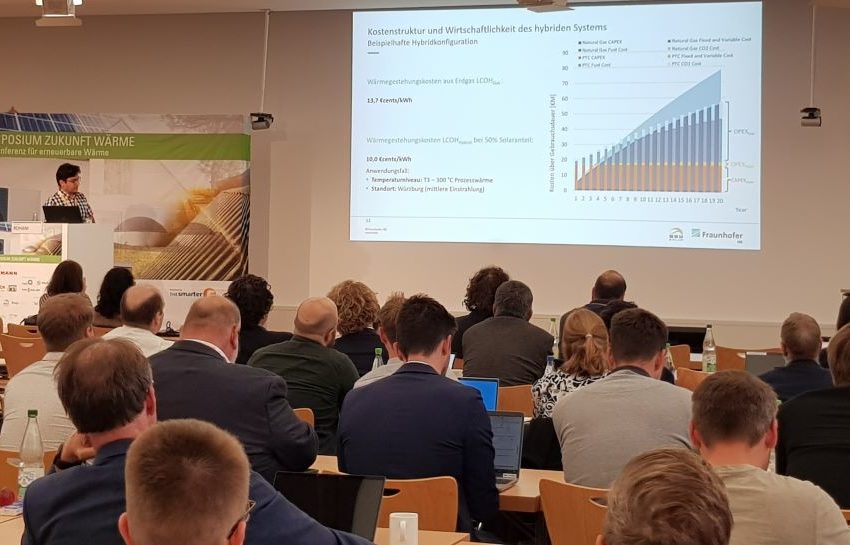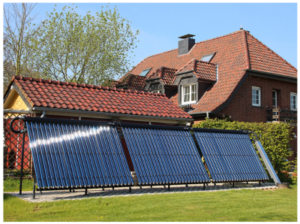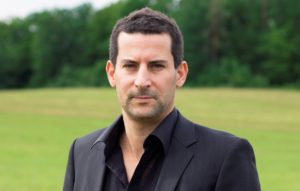Germany: Solar process heat 50 to 80% cheaper than gas-based alternatives
June 3, 2025
Solar process heat using concentrating collectors has proven to be economically viable in Germany. According to a recent study by the German Fraunhofer Institute for Solar Energy Systems ISE, presented by Dr. Shahab Rohani at the Symposium Zukunft Wärme (Future Heat), payback periods range from 3.4 to 7 years, depending on solar coverage and location. The levelized cost of heat (LCoH) is up to 50 % lower than that of gas-generated heat when taxes, levies and CO₂ prices are factored in. Commissioned by the German solar industry association BSW-Solar, the study included over 6,000 dynamic system simulations and considers three solar thermal technologies: flat plate, evacuated tube and parabolic tough collectors. The reference case was a factory with a continuous heat demand of 5 MW, currently met by gas boilers. The shortest payback period, achieved by a parabolic trough collector field, was just 3.4 years. In this case 120 °C solar heat was delivered with a low solar fraction of 14 % in southern Germany, taking into account a 50 % investment subsidy. The study written in German is available for download.
Photo: Solrico
“The study dispels the still widespread belief that solar process heat is not economically viable in low-radiation regions such as Germany”, commented Juliane Hinsch from BSW-Solar, regarding the findings.
This misconception was reflected by an opinion poll conducted during a workshop on the future of concentrating solar thermal systems held in the lead-up to the symposium. One third of the participating heat experts from industry and research agreed with the statement that concentrating solar heat is rather uneconomical in the German-speaking countries (see figure 1).
The workshop was part of the SolProNetz research project, which aims to support planners, contractors, and industrial heat users in integrating concentrating solar thermal systems into their heat planning and heat services.

Figure 1: Results of the opinion poll as part of the workshop “Future of concentrating solar heat” at the beginning of the Symposium Future Heat on 20 May in Germany Photo: Solrico
Industrial steam at 300 °C pays off in four years
To make the findings of the study easily accessible, the ProSolNetz partners have developed a series of infographics focusing on results for parabolic trough collector fields. Figure 2 shows the high variation of solar payback periods for such a field providing either 120 or 300 °C at the location of Würzburg, in central Germany. As a general rule, favourable payback periods of 4 to 5 years can be achieved with low solar fractions because no storage is required in this case.
The curves also clearly show that 300 °C applications have longer payback periods because the investment costs for the parabolic trough fields increase at higher temperatures and medium-temperature storage also results in higher costs.
It is also important to note that, thanks to the generous 50% investment subsidy provided by the Federal Programme for Energy and Resource Efficiency in the Economy (EEW), the investment achieves payback within 7.5 years, even with a 50% solar fraction. In this scenario, a 41 MW solar field is required along with a storage unit capable of 22 full-load hours. However, with this design not all of the solar heat can be utilized during the summer months, which increases the overall cost of solar heat.

Figure 2: Payback period in relation to solar fraction for medium-temperature process heat
Solar process heat found to be 50 to 80 % cheaper than gas-based alternatives
The study concludes that the LCoH from solar process heat ranges between 3 and 7 € cents/kWh, making it significantly more cost-effective than heat generated from gas, which is estimated at 13.6 €-cents/kWh (see Figure 3). The box plots illustrate LCoH values for different solar designs derived from thousands of simulations, which primarily vary based on local solar irradiation and the degree of solar coverage. For parabolic trough collectors (PTC), cost assumptions were derived from a combination of expert estimates and survey data to reflect the most current market prices available.
The authors adopted a conservative approach in calculating the LCoH for gas-based heat. They used a constant reference price of 7.8 €-cents/kWh, based on 2023 statistical data for a heat consumer with an annual demand of 44 GWh. This price includes a net gas cost of 5.6 €-cents/kWh, plus 2.2 €-cents/kWh for taxes and grid fees.
Assumptions related to CO₂ pricing are aligned with the moderate scenario from a former Fraunhofer study. In this scenario, the CO₂ price begins at 45 €/tonne CO₂ in 2024, increasing to 310 €/tonne CO2 by 2044.

Figure 3: LCoH for different industrial applications
11 MW collector field saves € 12 million in gas costs over 20 years
“Payback period is only one way to assess the economic efficiency of parabolic trough fields. It is equally important to consider the savings over the service life, which can be significantly higher with greater solar fractions – even though these typically come with longer payback periods and lower return on investment. Decision-makers should therefore weigh both short-term payback and long-term economic benefits when evaluating solar process heat systems”, explained Hinsch.
The savings are certainly impressive. For the variant described above, with 50 % solar coverage at 120 °C process heat, the investment of EUR 12.6 million generates gas savings of EUR 25 million. This corresponds to an IRR of 196 % (see Figure 4). With a lower solar coverage of 21%, investments of EUR 3.8 million generate savings of EUR 12 million over 20 years. Here, the investor benefits from an IRR of 310 %. In both cases, the savings are calculated on a discounted basis, that means terms of their present value.
The authors of the study conclude that investors in parabolic trough collector systems can achieve the highest returns on investment if they aim for moderate solar coverage rates of 20 to 30 %. Optimized system design and the available federal grants are therefore extremely important for economic efficiency.

Figure 4: Cost savings over the lifetime of a parabolic trough collector field providing process heat at 120 °C
Website of organizations mentioned in this news article:
BSW-Solar: https://www.solarwirtschaft.de/en/home/
Fraunhofer ISE: https://www.ise.fraunhofer.de/en.html
Solar Process Heat for the German Industry: https://www.ise.fraunhofer.de/en/research-projects/ship.html
ProSolNetz: https://www.solarwirtschaft.de/unsere-themen/csp/prosolnetz/


